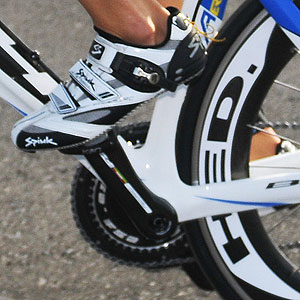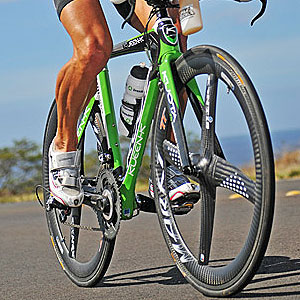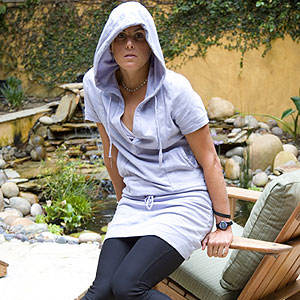Crank arm lengths for tri

One question I do not get in the never-ending quest by readers to wrest every scintilla of speed out of themselves and their machines is what length crank should I ride?
At first blush, the answer seems to be it doesn't much matter. But let's look a little further, because I think it does matter. Further, the answer is counterintuitive, as is often the case in this milieu.
Jim Martin is a cycliing enthusiast, a bicycle racer, holds a PhD in exercise science and an undergrad degree in mechanical engineering. He's a professor at the University of Utah and is as august an academic on the subject of crank length as anyone. The conclusion of his investigations is that it's hard to quantify a difference in efficiency between cranks lengths of 145mm and 195mm, regardless of a rider's heights. So why sweat it?
Crank lengths have been a topic of investigation for Velo News' tech editor Lennard Zinn for 15 years, and he's written, rewritten, recast and self-edited many times over the years, probably most notably in a long reply to a Velo News letter to the editor in 2003.
Therein he references an elegant formula for crank length published by Kirby Palm in which .216 X inseam is posited. So, if you have an inseam of 32", that's 813mm X .216 = 175mm crank arms. Lennard himself, at least as of 2003, prefers .21 X inseam, yielding in the case above 170mm cranks.
These are two of several such formulae. Others are Bernard Hinault's 28.4% of knee to trunk, and then just 10% of your height.
You'll notice a large variance in crankarm lengths if you use formulae built strictly on the notion of proportionality. Crankarms from 150mm to 195mm appear appropriate for riders ranging between 28" and 36" inseams. A formula like this intuitively flows from the notion of proportionality, and the fact that these cranks are not spec'd on bikes is probably more a result of fear of SKUs-run-amok by crank and bike manufacturers than by anything more rational. Anyone who's spectated bike makers trying to explain why they don't use 650c wheels on their smaller-sized bikes understand the mindset.
But there are detractors, notably Edward Zimmerman, who moderates proportionality based on factors such as the knee stress at the top of the stoke just when power is applied.
You'll note while reading most of these folks that they make mention of the use of longer cranks during timed race events. Zimmerman relates that, for time-trials and mountain stages it is not uncommon for elite cyclists to adopt longer cranks. Indurian, for example used 180mm cranks in time trials instead of his 175mm. Kirby Palm offers this: In time trialing, a slightly longer crank may also be beneficial. It allows optimum performance at a lower cadence, which by itself may seem helpful.
What I have failed to see, from the analysis of those listed above, is anything above a cursory sentence on the importance of the hip angle at top dead center, and how this question impacts the choice of crank length. More and more TT/Tri fitters—whose jobs are finding the appropriate bike positions of their charges—are focusing on this particular ergonomic metric: acute hip angle.
Kirby Palm may be onto something with his crank length formula, but he falls prey to two urban myths in the same sentence: that time trialing with a longer crank, and with a lower cadence, are each desirable things. Zimmerman notes, without refutation or commentary, that longer cranks are chosen in both mountain and time trial events, as if these specialties have a kinship requiring parallel technologies or techniques.

Most cyclists, whether road or tri, are cognizant of that pinched feeling at the top of the pedal stroke, if the back is too flat, or the saddle too far arears. Just as a half-squat is easier than a full-squat, commencing hip and knee extension is hard when levers are not allowed to function at a mechanical advantage. For this reason, aerobars that are too low create an environment in which power is lost.
Lengthening a crankarm creates problems for a timed racer. If you add 2.5mm to a crank's length, you lower your saddle that same 2.5mm to preserve your knee angle at bottom dead center, roughly 145° of included angle. At top dead center, then, that pedal axle is now 2.5mm closer to the torso, plus another 2.5mm, because that crank now sits 2.5mm higher above the BB axle. So, for every increment you lengthen the crank, your knee is double that increment closer to your torso as you start to apply power to the pedals at top dead center.
Your "closed hip angle," that is, your hip angle at top dead center, is probably between 46° and 52°, depending on your chosen landmarks, but this range is what you'll get using the trochanter as the angle's fulcrum, extending to the center of the knee, and to the acromion (shoulder bone). Our F.I.S.T. protocol measures open hip angle, or more precisely a proxy of it, and centers around 100°. In either case, in order to perserve these hip angles, the armrest drop—that vertical measure between the top of the saddle and the top of the armrest—must be increased by 5mm if the crank is lengthened by 2.5mm. This works against the athlete if he's trying to choose the most aerodynamic position available to him.
Furthermore, if events over the last decade are instructional, cadences are not trending lower in timed events, rather in the other direction. Perhaps a starting point for a discussion on cadence might be to posit the following: ride with a cadence equal to your functional threshold power + 5 beats. So, an Ironman ride at 80% of FTP might be ridden at 85bpm (beats per minute), and a 40k TT might be ridden at 98% FTP, or 103bpm. If you think this a high cadence, remember that only once since the 1960s has a world hour record been set at a cadence below 100.
But this would be just a starting point for what might be a further analysis into your perfect cadence, taking into consideration your morphology, your height, conditioning, fiber type, and so forth. My hope is not to segue into a discussion of perfect cadence, rather my points are two: that cadences in the timed events, at the highest levels of bike racing (where efforts rarely last more than an hour), are rarely observed below 90rpm and are often above 100rpm; and that cadences trend higher as the event grows shorter or, to put it another way, cadences go up as effort goes up.
You might add a third element that tracks up or down with cadence and effort: seat angle. If you consider just flat terrain, whether in a mass start event or in a timed event, as the effort goes up, the trunk moves forward—when Phil and Paul are describing the rider as "on the rivet" they're not talking about the rear rivet.
Why is this important? Because timed events, and triathlons, are not ridden with intervals of sitting up, riding easily—at least not by those who're in contention. Accordingly, saddles are forward, trunks are forward, backs are flat, and cadences are elevated. If you keep or make a crank arm short, an incrementally higher cadence is required to offset the lower torque generated by the shorter lever. But a higher cadence seems not only justified, but required, by timed racing. Alternatively, a longer crank arm is incrementally harder to spin at that higher cadence, all things equal. In other words, there is an elegant confluence with shorter cranks and higher cadences in timed racing; these elements are not in conflict, rather they complement each other.
This is not to suggest longer crank arms are not desirable, rather to say that longer crank arms do not dovetail nicely with the notion of flat backs; small frontal profiles; and closed hip angles that allow for appropriate leverage at the beginning of the power phase of the pedal stroke—especially if riding a faster cadence is a required element.
What both Jordan Rapp (my F.I.S.T. workshop "lieutenant" and one of triathlon's top cyclists) and I, in our n=2 experiment, have discovered is that we pair of 6'2" riders have found that 172.5mm cranks seem most appropriate for our own timed racing efforts. What I don't know is what my best crank arm length is for road riding. I rather think it depends on the specialty. For example, criterium riding is a lot more like timed racing than like, say, long ascents. My flat-back, on-the-rivet, hands-in-the-drops try like hell to keep the elastic from snapping seated sprint out of a corner is pretty much identical to my TT position, just that I don't have amrests under my elbows. Indeed, my closed hip angle in this position is 48°, identical to this angle in my TT position, as determined by a Retul motion capture analysis.
But while seated climbing my closed hip angle is about 5° more open, if it's a 6% or 7% climb we're talking about. And, during out-of-the-saddle climbing I've long thought a much longer crank would be more appropriate, both for the lower cadences most of us use out of the saddle, and for the sake of best balance aboard the bike.
So I cannot give you, as of this writing, an amount triathletes and time trialists should shorten their cranks versus what they'd use on their road race bikes because, even though I've been riding and occasionally racing road race bikes for 30 years, I've only just begun to think about whether my best crank length while climbing is really 175mm.
But what I can at least tell you is, regardless of what crank you ride on your road race bikes, and irrespective of the nature of your typical road riding session, your best time trial or triathlon crank length is certainly not longer—rather it's shorter—than what you'll use on your road bike.
Were I a product manager spec'ing cranks on my size run of TT/Tri bikes, I'd certainly start with cranks no longer than 165mm, and these would go on everything 50cm and below. I'd then add 2.5mm, which means finding the elusive 167.5mm lengths, every 3cm or 4cm worth of bike size increase, ending with 172.5mm on sizes 60cm down to 57cm, and 175mm arms on bikes only above 60cm in height.
This would dovetail with the smaller gears on these bikes required to ride the faster cadences, which advocates for 110mm bolt pattern cranks spec'd OE with 34×50 and 36×50 chain rings. Sadly, none of this sort of drive train spec is very often found on OE tri bikes these days.


